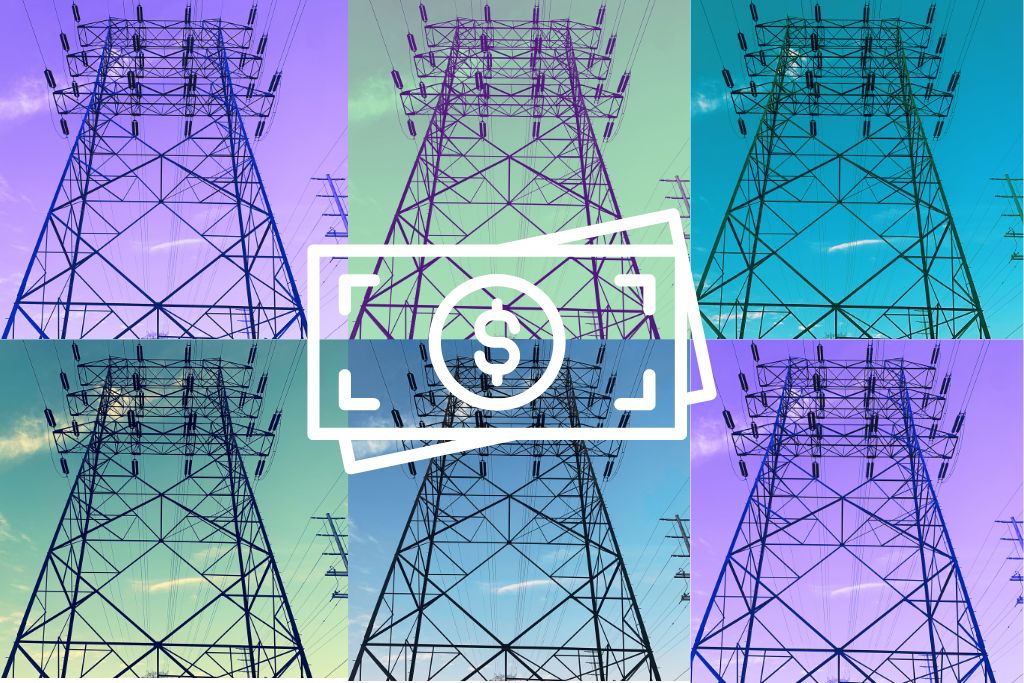Income-Based Electric Bills: Fact and Fiction
California is in the process of making income-graduated fixed rates a part of ratepayers’ electric bills. This is the first post in a series that follows that proceeding.

Under new legislation, California is moving to a novel system that includes income-based fixed charges for electricity. Some critics contend that this is a giveaway to incumbent utilities. It’s not. Others have implied that the charges reflect new costs to ratepayers on top of existing rates. This is also not accurate. There are, however, important questions regarding how the new rate structure will be designed and implemented.
In a series of posts, I’ll be following the ongoing proceeding at the California Public Utilities Commission (CPUC) charged with implementing this new policy. The series will dive into the material, financial, and equity concerns prompting the law, the practical design challenges for its implementation, and the ideological divisions between its supporters and critics. This introductory post will seek to clarify what the statute prompting the reform requires of the CPUC and explore the stakes of the new policy.
Public utility commissions are tasked with designing retail electricity rates that allow utilities to cover their costs and ensure that customers receive reliable and affordable electricity service. California regulators are facing challenges, however, as they balance goals to rapidly “electrify everything” without drastically increasing customers’ electricity bills or overloading the grid, and to equitably distribute the costs of grid operation and maintenance. This has become particularly difficult as the expansion of distributed resources like rooftop solar has reduced the customer base across which these costs are spread. The 2022 California law that requires the CPUC to implement the income-graduated fixed charges is one attempt to address these tensions. But this major change to electricity rates has inspired frustration and misunderstanding (a blog post from the authors of the Berkely study that initially proposed the policy addresses some of the common misunderstandings here).
So, what does AB 205 actually require? The Legislature’s stated intent in shifting a portion of rates from volumetric charges (i.e., charges based on how many kilowatt hours of electricity customers consume) to the new income-based fixed charge was to “help stabilize rates, equitably allocate and recover costs among residential customers,” and to “ensure that the fixed charges are established to more fairly distribute the burden of supporting the electric system and achieving California’s climate change goals…” The relevant provisions of the statute amend Section 739.9 of the California Public Utilities Code with three major moves. The law requires CPUC to:
Separate out a charge to cover fixed costs by July 2024
First, the statute permits the CPUC generally to “adopt new, or expand existing, fixed charges for the purpose of collecting a reasonable portion of the fixed costs of providing electrical service to residential customers,” and specifically requires the commission to authorize a fixed charge for default residential rates “no later than July 1, 2024.” The Commission has yet to determine exactly which costs will be incorporated into the new fixed charges, but they should be costs that do not vary based on customers’ energy use. Party comments from the major investor-owned utilities urged the Commission to adopt a set list of all costs that do not vary with usage, which would “comprise the existing universe of fixed cost categories that would be eligible for potential inclusion” in an income-graduated fixed charge. Party comments from the California Public Advocates Office suggested that these costs “should include but are not limited to; marginal customer access cost, non-marginal distribution costs, public purpose related charges, and wildfire-related charges.” Sierra Club and the California Environmental Justice Alliance offered specific suggestions of charges to include, such as the costs of nuclear decommissioning, PG&E’s Energy Cost Recovery Amount, and various costs of ensuring emergency preparedness and resilience (like the Wildfire Fund Non-Bypassable Charges and the Wildfire Hardening Charge).
Apply the flat charge on an income-graduated basis
Next, the law requires these fixed charges to “be established on an income-graduated basis with no fewer than three income thresholds.” So, who will pay how much? Commenters to the proceedings are currently weighing in on how much the income-graduated charge should reduce bills for low-income customers, whether the Commission should adopt a definition of moderate-income customers, whether there should be a cap on the initial increase in average monthly bills or high-income customers, among other questions related to the income-graduated design. Parties to the proceeding are also grappling with the practical challenge of evaluating income for millions of customers. In their initial comments, the major investor-owned utilities recommended that the first round of income-graduated fixed charges use four income brackets that partially rely on existing income data from the low-income California Alternative Rates for Energy and Family Electric Rate Assistance programs.
Ensure that the charge aligns with equity and conservation goals
Finally, the law requires that the new fixed charges meet three criteria. The fixed charges must:
- Reasonably reflect an appropriate portion of the different costs of serving small and large customers.
- Not unreasonably impair incentives for conservation, energy efficiency, and beneficial electrification and greenhouse gas emissions reduction.
- Be set at levels that do not overburden low-income customers.
Just a week ago, the Administrative Law Judge in the case issued a ruling that laid out the near-term timeline for the proceeding and guidance for the opening briefs that parties will be submitting this fall. The opening briefs are directed to focus on issues necessary to authorize the first round of income-graduated fixed charges and only to address the procedural aspects of issuing the second round of charges.
AB 205 passed easily as a trailer bill but has received a significant amount of press and pushback since it was signed into law. Critics argue that the new policy will discourage energy efficiency and (conversely) that it will not encourage electrification because customers focus on their overall bill rather than parsing the difference between fixed charges and volumetric rates. A vocal contingent of homeowners who have invested in rooftop solar have taken to the CPUC public comments to express their ire over what they see as a bait and switch: having been encouraged to invest in solar only to have the structure of rates change in a way that reduces the benefit of solar investments. Supporters say that the new rate structure is essential to California’s electrification goals and to ensuring affordable and equitable rates. Supporters include environmental non-profits, the public advocate, and California’s three big investor-owned utilities, PG&E, SoCal Edison, San Diego Gas & Electric, which submitted a joint proposal in the CPUC proceeding. I will be digging into each of these assertions in coming posts.
At stake is California’s ability to electrify—a key component of California’s climate goals—and electricity affordability. The unfolding proceeding will be an important site for public conversation not only about electrification and affordability, however, but also about the broad purpose and the technical details of electricity rate design. The anger the policy has prompted has exposed a set of fundamentally different frameworks, both descriptive and normative, for understanding electricity ratesetting. The ongoing debates highlight the fundamental tensions between incentivizing broad-scale electrification and incentivizing electricity conservation. The proceeding begs technical questions about how the charges can be effectively implemented on an income-graduated basis. The debate and resolution of each of these questions will have implications for the future of ratesetting in California and nationally.
Reader Comments
12 Replies to “Income-Based Electric Bills: Fact and Fiction”
Comments are closed.






Thank you for this. An objective explainer of this important issue was much need.
The establishment of a fixed charge to recover the truly fixed cost of connecting to the grid is very common in electricity rate design. The average, across all regulated utilities in the US, is about $11/month. California is an outlier at less than $1/month for the three big utilities, PG&E, SCE, and SDG&E.
It would be entirely reasonable to establish a cost-based fixed charge at this level. It could then be given a partial discount for the low-income customers served under the FERA program (who now get about an 18% discount on their bills), and discounted back to zero for the very low income customers served under the CARES program (who now get about a 35% discount.
That would satisfy the legal requirement set in the budget trailer, and result in rates that are generally consistent with industry standards around the country.
The problem is that some extreme advocates are insisting on recovering more than the truly fixed costs to connect to the grid, turning this into a huge income transfer scheme. That should be rejected by the California PUC.
Thanks for your comment, Jim! A future post will address rate design more generally to contextualize the new fixed charge and identify, to your point, what’s unique about it and what’s not.
Are commercial electricity rates also regressive? I am a bit curious why residential customers should have to pay all the wildfire costs?
It also seems that just developing this fixed cost data would be enough for a first step.
I don’t know that I care for the PUC much, and I’m not sure that I want them having “equity” as an excuse for more shenanigans. (Though, maybe they aren’t so bad. It is a complicated subject.) Also, I’m not sure why we still need investor owned utilities.
I agree with helping low income people afford electricity – it is just that “equity” can be used cynically. And I *think* I would rather have subsidies than have people be charged different prices for the same thing. I am not sure it is a good thing to separate groups of people like this. We do this too much already.
Also, I was confused by this bit: “adding more rooftop solar without batteries does little to reduce carbon emissions or help the grid. ”
Doesn’t that reduce emissions … all day long?? Isn’t that good? I don’t get it.
I’d be interested if there were more specifics about the regressivity, especially if it is based on California.
This is just out of curiosity though. I don’t doubt that it is most likely an issue. Everything costs you a bigger proportion when you are poor – as they say, “duh…”
I wonder if it’s true that we can never have these big new costs be part of the state budget. Come to think of it, would it help if we finally killed the HSR? I admit that I am not filled with confidence when I think of the state government.
These plans are insane. Punishing people for their incomes is unbelievable. Have you considered that more people with higher incomes will simply move out of California- as we are considering this as a viable option at this point. The answer to higher price is expanding production. Solar is fine for the day but never will be enough for the night even with battery storage. We need nuclear energy expansion. Nuclear energy is clean and cheap. Its the only way forward.
Well, many electricity rate designs include a fixed charge to recover the fixed costs associated with connecting to the grid. This fixed charge is meant to cover the costs that are not dependent on the amount of electricity consumed, such as infrastructure maintenance and grid operation. Developing accurate data on these fixed costs is indeed an important first step in establishing fair and consistent rates. By understanding the true fixed costs, utilities can set appropriate charges that align with industry standards and legal requirements. This helps ensure that customers are billed fairly and that the utility can recover its costs in a sustainable manner. However, the goal is generally to strike a balance between recovering costs and providing affordable and reliable electricity to consumers.
“. . .without drastically increasing customers’ electricity bills . . ”
Doesn’t California already have the highest electricity rates (except for maybe Hawaii and Alaska)?
I do think the author does a really nice job covering this topic.
Do we know how the utility companies are going to verify income?
Exactly… people will certainly game the system: Simply put the power bill in your kid’s name, since their income is zero and they do, after all live at that address.
Also, a side note on the wildfire-related changes: As long as we’re adding transparency to fixed costs, once the wildfire-related costs are in they’re own separate pot, aren’t we due for a rebellion by city dwellers who conclude they unfairly subsidize those who chose to live in the fire zone? A wealth of sins can hide in “overhead rates,” but once there is separation there starts to be transparency. And with transparency comes a fresh cadre of pissed off people.
Thanks for this article! My colleague and I have developed a series of blogs on this issue, available here: https://www.nrdc.org/news-commentary?f%5B0%5D=news_commentary_language%3Aen&f%5B1%5D=news_commentary_author%3A22011#listing-page-content
Happy to discuss further.